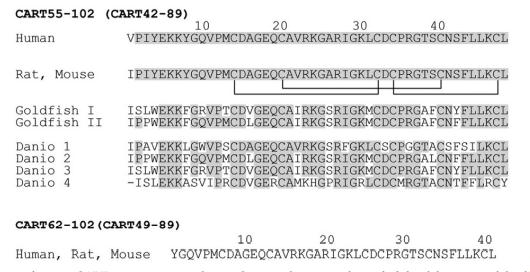| Identification | Back Directory | [Name]
CART (55-102) (RAT) | [CAS]
209615-79-2 | [Synonyms]
CART (55-102)
CART (RAT, 55-102)
CART (55-102) (RAT)
CART, MOUSE/RAT, (55-102)
CARP, MOUSE/RAT, (55-102)
CART Fragment 55-102 rat
CART Fragment 55-102 human
CART PEPTIDE (AA 55-102), RAT
COCAINE- AND AMPHETAMINE-REGULATED TRANSCRIPT
COCAINE-AND AMPHETAMINE-REGULATED TRANSCRIPT (55-102) (RAT)
COCAINE- AND AMPHETAMINE-REGULATED TRANSCRIPT (RAT, 55-102)
COCAINE- AND AMPHETAMINE RELATED TRANSCRIPT, MOUSE/RAT, (55-102)
IPIYEKKYGQVPMCDAGEQCAVRKGARIGKLCDCPRGTSCNSFLLKCL (DISULFIDE BRIDGE: 74-94,68-86 AND 88-101)
ILE-PRO-ILE-TYR-GLU-LYS-LYS-TYR-GLY-GLN-VAL-PRO-MET-CYS-ASP-ALA-GLY-GLU-GLN-CYS-ALA-VAL-ARG-LYS-GLY-ALA-ARG-ILE-GLY-LYS-LEU-CYS-ASP-CYS-PRO-ARG-GLY-THR-SER-CYS-ASN-SER-PHE-LEU-LEU-LYS-CYS-LEU
H-ILE-PRO-ILE-TYR-GLU-LYS-LYS-TYR-GLY-GLN-VAL-PRO-MET-CYS-ASP-ALA-GLY-GLU-GLN-CYA-ALA-VAL-ARG-LYS-GLY-ALA-ARG-ILE-GLY-LYS-LEU-CYS-ASP-CYS-PRO-ARG-GLY-THR-SER-CYS-ASN-SER-PHELEU-LEU-LYS-CYS-LEU-OH
H-ILE-PRO-ILE-TYR-GLU-LYS-LYS-TYR-GLY-GLN-VAL-PRO-MET-CYS-ASP-ALA-GLY-GLU-GLN-CYS-ALA-VAL-ARG-LYS-GLY-ALA-ARG-ILE-GLY-LYS-LEU-CYS-ASP-CYS-PRO-ARG-GLY-THR-SER-CYS-ASN-SER-PHE-LEU-LEU-LYS-CYS-LEU-OH
H-ILE-PRO-ILE-TYR-GLU-LYS-LYS-TYR-GLY-GLN-VAL-PRO-MET-CYS-ASP-ALA-GLY-GLU-GLN-CYS-ALA-VAL-ARG-LYS-GLY-ALA-ARG-ILE-GLY-LYS-LEU-CYS-ASP-CYS-PRO-ARG-GLY-THR-SER-CYS-ASN-SER-PHE-LEU-LEU-LYS-CYS-LEU-OH (DISULFIDE BRIDGE: 74-94, 68-86, AND 88-101)
ILE-PRO-ILE-TYR-GLU-LYS-LYS-TYR-GLY-GLN-VAL-PRO-MET-CYS-ASP-ALA-GLY-GLU-GLN-CYS-ALA-VAL-ARG-LYS-GLY-ALA-ARG-ILE-GLY-LYS-LEU-CYS-ASP-CYS-PRO-ARG-GLY-THR-SER-CYS-ASN-SER-PHE-LEU-LEU-LYS-CYS-LEU: IPIYEKKYGQVPMCDAGEQCAVRKGARIGKLCDCPRGTSCNSFLLKCDISULFIDE BRIDG
CART (55-102) (rat) H-Ile-Pro-Ile-Tyr-Glu-Lys-Lys-Tyr-Gly-Gln-Val-Pro-Met-Cys-Asp-Ala-Gly-Glu-Gln-Cys-Ala-Val-Arg-Lys-Gly-Ala-Arg-Ile-Gly-Lys-Leu-Cys-Asp-Cys-Pro-Arg-Gly-Thr-Ser-Cys-Asn-Ser-Phe-Leu-Leu-Lys-Cys-Leu-OH (Disulfide bonds between Cys68 and Cys86/Cys74 and Cys94/Cys88 and Cys101)
L-Leucine,L-isoleucyl-L-prolyl-L-isoleucyl-L-tyrosyl-L-α-glutamyl-L-lysyl-L-lysyl-L-tyrosylglycyl-L-glutaminyl-L-valyl-L-prolyl-L-methionyl-L-cysteinyl-L-α-aspartyl-L-alanylglycyl-L-α-glutamyl-L-glutaminyl-L-cysteinyl-L-alanyl-L-valyl-L-arginyl-L-lysylglycyl-L-alanyl-L-arginyl-L-isoleucylglycyl-L-lysyl-L-leucyl-L-cysteinyl-L-α-aspartyl-L-cysteinyl-L-prolyl-L-arginylglycyl-L-threonyl-L-seryl-L-cysteinyl-L-asparaginyl-L-seryl-L-phenylalanyl-L-leucyl-L-leucyl-L-lysyl-L-cysteinyl-,cyclic(14→32),(20→40),(34→47)-tris(disulfide)
L-Isoleucyl-L-prolyl-L-isoleucyl-L-tyrosyl-L-alpha-glutamyl-L-lysyl-L-lysyl-L-tyrosylglycyl-L-glutaminyl-L-valyl-L-prolyl-L-methionyl-L-cysteinyl-L-alpha-aspartyl-L-alanylglycyl-L-alpha-glutamyl-L-glutaminyl-L-cysteinyl-L-alanyl-L-valyl-L-arginyl-L-lysylglycyl-L-alanyl-L-arginyl-L-isoleucylglycyl-L-lysyl-L-leucyl-L-cysteinyl-L-alpha-aspartyl-L-cysteinyl-L-prolyl-L-arginylglycyl-L-threonyl-L-seryl-L-cysteinyl-L-asparaginyl-L-seryl-L-phenylalanyl-L-leucyl-L-leucyl-L-lysyl-L-cysteinyl-L-leucine cyclic (14-32),(20-40),(34-47)-tris(disulfide) | [Molecular Formula]
C226H367N65O65S7 | [MDL Number]
MFCD01865992 | [MOL File]
209615-79-2.mol | [Molecular Weight]
5259.18 |
| Questions And Answer | Back Directory | [Structure]
CART peptides of different lengths have been found
in various tissues. The rat central nervous system contains CART55–102 and CART62–102 fragments. In the
periphery, longer products are generated in addition to
CART55–102. Adrenal glands in the rat produce two
peptides, CART1–89 and CART10–89. The most widely
studied peptides are CART55–102 and CART62–102 . Both peptides contain a cysteine-knot motif,
which is critical for the biological activity of the hormone. The human CART42–89 corresponds to the rodent
CART55–102. Genome studies
have revealed that fish have multiple CART genes.
Two different goldfish CART55–102 (Goldfish I and II)
genes present high homology with their mammalian
counterparts in their C-terminal end region.
 | [Gene, mRNA, and precursor]
The human CART gene, CARTPT, located in the 5q13.2
region, consists of two introns and three exons. Due to
alternative splicing, the rodent CART mRNA produces
two spliced variants of proCART. Long and short forms
encode a 102 aa sequence or an 89 aa sequence, respectively. Only the latter has been found in humans. | [Synthesis and release]
In hypothalamic explants, the neuropeptide Y (NPY)
significantly increased the release of CART (55–102)
immunoreactivity. In vivo experiments showed that leptin administration induces Fos expression in hypothalamic CART neurons. NPY and CART are coexpressed
in the same neurons in the dorsomedial hypothalamus
in chronic obesity. These neurons are activated by peripheral leptin treatment in diet-induced obesity. Thus, CART
peptides are anorexigenic and closely associated with
leptin and NPY, two important food intake regulators.
CART is also released in response to repeated dopamine
release in the nucleus accumbens. | [Biological functions]
In the goldfish, the central administration of human
CART has been shown to decrease food intake. In mammals, CART modulates various physiological processes
such as feeding, energy expenditure, stress control, and
endocrine secretion. | [Receptors]
Although CART-responsive cell lines or neurons were
reported, the receptor for CART has not been clarified yet. It is speculated that CART55–102 and
CART62–102 do not share the same receptor, as they
show different physiological activities in vivo. In 2020,
CART55-102 was suggested to be a ligand of an orphan
GPCR, GPR160, from biological assays. Further pharmacology would be required on GPR160 and CART for
confirmation. The signal transduction pathway is predicted to be
mainly coupled to the Gi/o protein and to stimulate
ERK1/2 activation or inhibit calcium signaling. | [Clinical implications]
In an obese 10-year-old boy, where the onset of obesity
was at the age of 2, a G-to-C transversion at nucleotide
729 of the CART gene was identified, resulting in missense mutation, a leucine to phenylalanine substitution
at codon 34 (L34F). This mutation affects posttranslational processing and causes bioactive CART deficiency
in the serum. The L34F mutation segregated with severe
obesity over three generations in this family, and was not
identified in the control population. The affected subjects
demonstrated reduced resting energy expenditures. Further, sequence variability in the CART gene has been
identified as being related to obesity in several hundred
French subjects. |
| Hazard Information | Back Directory | [General Description]
CART, so named because of upregulation by cocaine and
amphetamine, is thought to be involved in the regulation of
feeding and stress. However, its cognate receptor has not
yet been identified. In the 1980s, a fragment of the CART peptide was identified in an extract of ovine hypothalamus. Fifteen years
later, the level of CART mRNA was found to increase
in the rat striatum after acute administration of cocaine
and amphetamine. Subsequently, in 1999, CART peptides were extracted and sequenced from the rat, and it
was found that two different forms (CART55–102 and
CART62–102) were present. | [storage]
Store at -20°C |
|
|